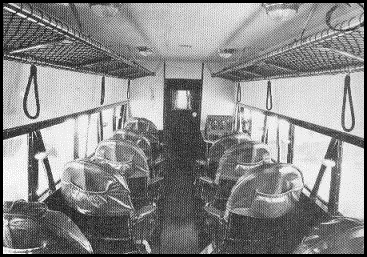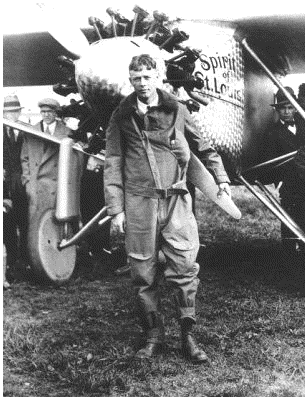Across
America
The Airline
Passenger Experience
Daniel L. Ruse
(University of Oklahoma Press)

The first regular commercial airline service was aboard a Boeing 40A, running between San Francisco and Chicago. It had room for but two passengers. You had to crawl in over the wing. Women in hobble-skirts need not apply.
The two most famous early travelers were Notre Dame's football coach Knute Rockne and comedian Will Rogers. Knute died in a crash in Cottonwood Falls, Kansas in 1931; Rogers disappeared on a flight in Alaska in 1935.
One of the most popular airplanes of the day, Knute's last, was the Ford Tri-Motor. Windows on these could be popped open to bring in fresh air. Passengers often dropped ashes and cigarettes on the farmers below until the U. S. Department of Agriculture protested, claiming they were going to set innocent Wilderness Areas aflame.
The first stewardesses appeared in 1930, working for United Air Lines. These ladies carried the luggage for the passengers, helped refuel the airplane, and provided cotton for those bothered by the noise of these early motors.
- The presence of female airline employees aboard commercial planes could serve notice to the nonflying public that if flying was safe for young women, it must be safe for all.
In 1930, it took thirty-six hours to fly from New York to Los Angeles. After World War II, airlines developed turbojets to cut the flying time to ten hours. But the 18-cylinder piston engines --- complete with 144 spark plugs --- were difficult to maintain. In the Douglas DC-7, "All too often these complicated assemblages failed during flight."
- American Airlines stockpiled engines for its DC-7s in Denver, even though it was not a scheduled stop, because transcontinental flights made emergency landings there so often in need of an engine replacement.
"In the 1950s, TWA sometimes experienced 10 engine failures per day on its large airliners. Piston engines were stretched to their technological limit, and the airlines needed a new source of propulsion." Enter the jet.
I am old enough to remember the early flights of jets. It was 1959. I had been husband and father for a couple of years and needed a dignified exit. I got myself a ticket on a direct flight from San Francisco to New York. "Business," I said. "I'll be back," I said.
Even before we got off the ground, things besides my marriage started falling apart. I tried to open the tray table: it came off in my hands. When we started to take off, the wings waggled. On the old Douglas DC-7 the tray tables were sturdy, the motor-mounts never moved. "The wings are going to fall off," I thought. I figured god was punishing me for running away from wife and child.
Flying Across America is 250 pages long, weighs in at four or five pounds. There are chapters on "nonsked flights," wartime service, and segregation at southern airports. Jackie Robinson and his wife Rachael were bumped in route to Miami from an American Airlines flight in New Orleans. Much space is devoted to the simmering question about whether booze should have or not have been served in the air.
There is a chapter on experiments in entertainment to relieve the boredom of being in a long box cut off from the world below for too many hours. We learn here that the first inflight movies were offered on Trancontinental Air Transport (TAT) in 1929, that the earliest jumbo jets had a cocktail lounge in "the fairing" (a hump behind the cockpit), and that the growth of low-fare airlines forced regular servers to cut perks ... the first being American Airlines radical decision, in 1986, to eliminate olives from salads.
 There's a lot missing here. The chapter on security does not hint that many would-be visitors to America stay away now because of the onerous, undignified and mostly unnecessary body searches, coupled with the intransigence of federal immigration agents.
There's a lot missing here. The chapter on security does not hint that many would-be visitors to America stay away now because of the onerous, undignified and mostly unnecessary body searches, coupled with the intransigence of federal immigration agents.
There is no mention of the international flim-flammery that marks the sordid history of Pan American Airways. Nothing is said of the ugly political clout of airlines and manufacturers: for years Boeings owned the omnipresent, obnoxious senator from Washington State, Henry Jackson. And there is nothing concerning the airlines flagrant control of the Civilian Aeronautics Board, not unlike broadcasters owning the Federal Communications Commission.
But if you are in it for a lark, and I definitely am, the photographs are worth the whole long noisy journey.